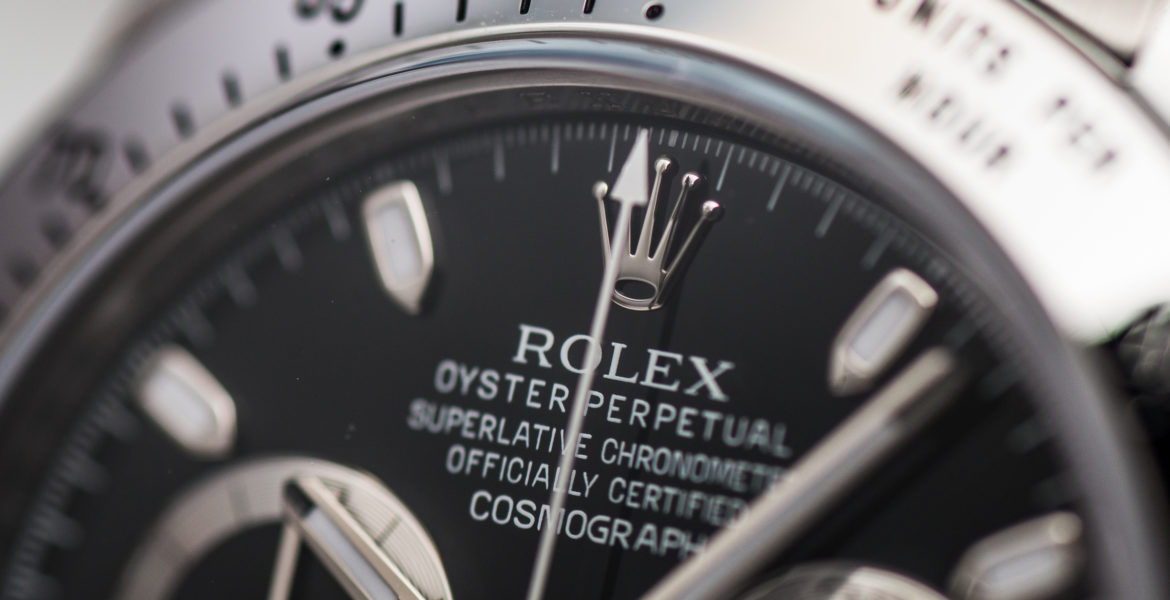Luxury watches are more popular today than ever before. It seems everyone is dying to get their hands on timepieces from the top brands. But with this surge in interest comes a new concern. The question on the lips of all watch buyers: is it real? The market has fallen prey to a flood of replica watches of ever increasing quality, and it's becoming harder to distinguish an authentic item among all the fakes. Fortunately, we are here to help you get fully informed with our handy buyer's guide to identifying the Real McCoy. Today we look at the king of watchmakers: Rolex.

Is it real? A buyer's guide to spotting a fake Rolex

Let the Experts Do Their Thing
Before we get into it, of course, you can never be too sure when it comes to spotting a fake Rolex. While the tips below will help you avoid any glaring fakes, there are some replicas that are so cunning that they fool even the most experienced collector. The only way to be absolutely sure you are getting the real product is to buy from a trusted seller. CHRONEXT ensures authenticity for 100% of its watches with its authentication process. Our certified CHRONEXT watchmakers in our master workshop in Cologne, Germany inspect every nook and cranny of the watches we sell, sussing out even the tiniest whiff of counterfeit techniques, giving customers total peace of mind. Learn more about our CHRONEXT watchmaking atelier on our About Us Page and make sure you know the facts to buy your watches responsibly.
Rolex is one of the greatest watchmakers of all time – when you buy a Rolex you should expect the highest quality in every aspect of your timepiece. Many replicas can be identified immediately by their clearly shoddy manufacturing. Others are a lot harder to spot. Here, we present you with 5 tips to better understand how to spot a fake Rolex Cosmograph Daytona.
Know Your Stuff
The first thing to do is research: learn everything about the watch and retailer. Ideally you want to see papers for the specific watch being sold. You should determine exactly which model you want to buy and make sure every component is as it should be – everything from bracelet to serial number – and you should know roughly how much it should cost. The serial number is the vital Rolex identification for every Rolex watch. You can traditionally find it engraved on the top of the case between the lugs, although modern watches put it on the rehaut at 6 o'clock. Check to make sure the serial is not one of many known fakes. It should be cut clearly and deeply in the metal, and should not appear shallow or “sandy” as it does in some fakes.

Every type of Rolex watch has spawned legions of fakes, each with their own quirks and irregularities that can be spotted by the experts. The most commonly faked watches include the Datejust, Submariner, Yacht-Master and the Oyster Perpetual – as well as the other famed series we will look at now: the Rolex Cosmograph Daytona.

Devil in the Detail
When it comes to comparing real Rolex vs fake knock-offs, the difference lies in the slightest imperfections. The dial is often the easiest place to start – any irregularity in the font, smudged lettering or strange spaces between letters would never have made it past Rolex quality control and should set off alarm bells. Next, check the case – any strange or poorly made markings are signs of a replica. A real Rolex has nothing at all on the caseback (exceptions are models with helium valve: Sea-Dweller and Sea-Dweller Deepsea). The only engravings are between the lugs: Serial number at the top, model number at the bottom. You should also check the watch's basic functionality: some fakes have obvious giveaways you might forget about, like a non-functional chronograph, an exhibition caseback or a date window (a real Daytona never has a date window).

The Old Ticker
After a careful inspection of the case and dial, your next step is to put the watch to your ear. Don't hear any ticking? It's most likely a fake, because Rolex models have a mechanical movement (except the Rolex Oysterquartz). In addition, Rolex movements are known for the sound called "Glockenspiel" in enthusiasts' circles: when you hold the watch close to your ear and listen for a few seconds, the continuous ticking of the escapement mechanism will turn into a bell-shaped ringing. However, the absolute best way to identify a fake is to inspect the movement. You should seek professional help in this to ensure you do not accidentally damage the watch. A real Rolex has a superb, self-winding in-house calibre, while fakes typically use a mass-produced ETA movement.

The Coup de Grâce
There are other tricks to spot a fake Daytona. For example, modern Daytonas are equipped with the brand's patented Triplock system. This can be found by pulling out the crown to reveal a special rubber gasket that fakes commonly miss. Also check the quality of the lume on the indexes, and telltale signs like the engraving on the rehaut (modern watches are engraved ROLEXROLEXROLEX – not printed or painted). On the underside of the crystal at 6 o'clock modern Rolexes show another crown logo – this one etched at a size so small it is almost invisible to the naked eye.
